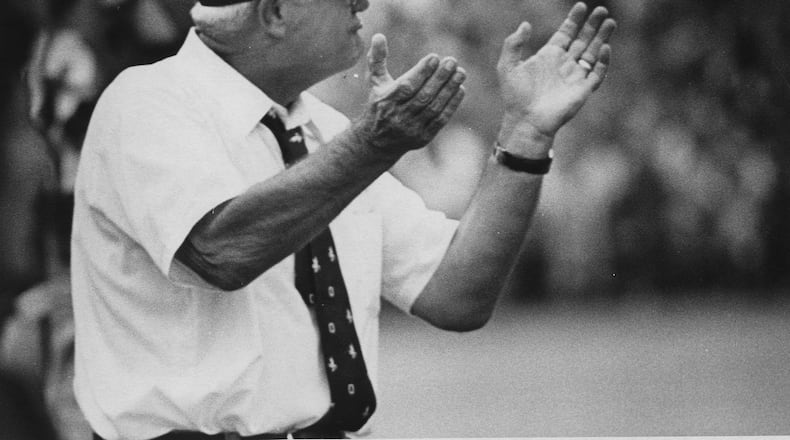Even though I grew up in Columbus and knew all about Hayes’ reluctance to throw passes while he coached at Ohio State, I didn’t know why Hayes was such a stickler for the running game.
RELATED: Ohio State's Bosa No. 2 overall pick
RELATED: Redskins draft Buckeyes' Haskins
RELATED: Four facts about OSU's first-round draft history
Oh, I know, he and others of his ilk often repeated the tired refrain, “When you throw a pass, three things can happen, and two of them are bad (incompletions and interceptions).”
I also looked into the record book and found in Hayes’ second season, 1952, OSU quarterback John Borton not only threw for 1,555 yards, he led the nation with 15 touchdown passes.
We’re talking about quarterbacks here because Ohio State is looking for one, preferably one who can fling it. At the moment, that would be Georgia transfer Justin Fields, long on talent, way short on experience.
Of course Dwayne Haskins didn’t have much experience last season and threw for 4,831 yards with a 50-8 touchdown passes to interceptions ratio.
When he threw a pass, it was almost always a good outcome.
Hayes had a much different outlook until in 1978 he signed Miami Trace High School standout Art Schlichter, a guy who was – as a true freshman - going to replace incumbent starter Rod Gerald and usher OSU into the passing game.
How insignificant was OSU’s passing game until then? Halfback Don Clark led the team with 88 passing yards in 1956. He completed three of seven throws. Not all years were like that, but OSU was not leading the nation in passing, either.
I asked Dayton Daily News sports editor Si Burick if there was an incident that convinced Hayes his “three yards and a cloud of dust” philosophy was best.
Burick suggested I call Hayes and ask, and to be prepared for Hayes to answer the phone himself, which is what happened.
Hayes, entering his 28th (and, as it turned out, last) season at OSU, stopped me in mid-sentence to talk about Schlichter. He went on for about 15 minutes before pausing when I asked, “But what about Borton?”
Always direct, Hayes said, “I think you have enough for a good story” and hung up.
I did have a good story. As I used to say to eventual OSU coach John Cooper all the time, if Hayes only gave you 30 seconds, it was the best 30 seconds of your day.
“He’s like that,” Burick said when I recounted the conversation.
Many years later, after Hayes was already gone, I met former OSU assistant coach and longtime Middletown Middies coach Glenn “Tiger” Ellison, the guy many consider the father of run-and-shoot football, which became the West Coast Offense.
“When I went with Woody in 1963, at our first staff meeting, we got at this long table, all the assistant coaches sitting and Woody standing,” Ellison said. “He told me, ‘Tiger, get up there and talk about that run-and-shoot thing.’”
For the next hour, Ellison diagrammed plays on the chalkboard to a wide-eyed staff. All of them, Ellison remembered, where shaking their heads in the affirmative.
Hayes stood in the corner, arms folded, shaking his head no.
“He let me be the quarterback coach, but no run-and-shoot,” Ellison said.
Actually, Hayes relented a little, allowing a few run-and-shoot plays for quarterback Rex Kern, who led the team to the 1968 national championship, after which Ellison retired.
The next two seasons, the Buckeyes came close to repeating, but did not.
It wasn’t because they didn’t pass enough … although, maybe, it was.
About the Author
